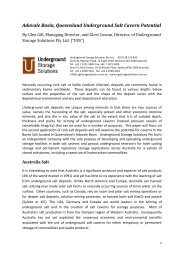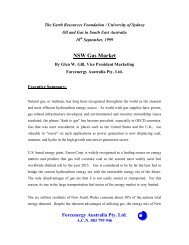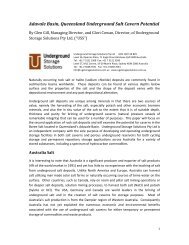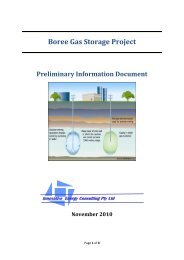Underground Gas Storage Glossary - Innovative Energy Consulting ...
Underground Gas Storage Glossary - Innovative Energy Consulting ...
Underground Gas Storage Glossary - Innovative Energy Consulting ...
You also want an ePaper? Increase the reach of your titles
YUMPU automatically turns print PDFs into web optimized ePapers that Google loves.
<strong>Innovative</strong> <strong>Energy</strong> <strong>Consulting</strong> Pty Ltdnecessary to operate and protect the storage project, including producing wells ina buffer zone around the project.Cushion gas: The quantity of natual gas held within the confines of theunderground gas storage container intended as permanent inventory required forreservoir management purposes and to maintain an adequate Minimum <strong>Storage</strong>Pressure. Cushion <strong>Gas</strong> is rarely, if ever, produced and the amount of Cushiongas required is dependent upon the reservoir quality, number ofinjection/withdrawal wells, gas withdrawn schedule, amount of compression, andfield operating parameters. The Cushion <strong>Gas</strong> volume may consist of recoverableand non-recoverable in-situ gas volumes and injected gas volumes. One of thelargest cost components for an UGS project is the purchase of Cushion <strong>Gas</strong> priorto placing the facility into service. UGS facilities tend to have a long operating lifethereby destroying the present value of the ultimate recovery and sale of Cushion<strong>Gas</strong>. One of the ongoing optimizations of any UGS project is to balance theCushion <strong>Gas</strong> requirements and costs related thereto with the costs of additionalinstalled compression that would be required to lower the Cushion <strong>Gas</strong>requirement. The ratio of Cushion <strong>Gas</strong> to Working <strong>Gas</strong> Capacity or to Total <strong>Gas</strong>Capacity has a significant impact on the economics of storage operations due tothe upfront capital and carrying cost of this gas inventory. Typically Aquifer gasstorage has a very high Cushion <strong>Gas</strong> requirement (80% of the Total <strong>Gas</strong>Capacity), Depleted reservoir gas storage has the next highest requirement (30%to 70% of the Total <strong>Gas</strong> Capacity) and salt cavern gas storage has the lowestCushion <strong>Gas</strong> requirement (typically 20% to 30%).Cycle: One storage cycle is the theoretical time required to completely inject andwithdraw the working gas quantity for any given underground gas storage facilityor the turnover time for the working gas capacity rating of the facility. The cyclerate of any storage facility is usually expressed in cycles per year and is thenumber of times the working gas volumes can theoretically be turned over eachstorage year. The cycle rating for Porous <strong>Storage</strong> varies from 1 to 6 per yearwhile that for Salt Cavern <strong>Storage</strong> are as high as 12 per year.Days Service: The Days Service is another manner in which to describe thecapability of an UGS facility or the rights of a storage customer pursuant to aFirm <strong>Gas</strong> <strong>Storage</strong> Service contract to cycle working gas capacity. The DaysService refers to the number of days required to completely withdraw theMaximum Working <strong>Gas</strong> Inventory associated with a facility or a storage contract.The following table matches Days Service with Annual Cycling Capability:# Days Service Annual Cycling Capability10 1830 960 490 2150 1<strong>Underground</strong> <strong>Gas</strong> <strong>Storage</strong> Terminology 4










